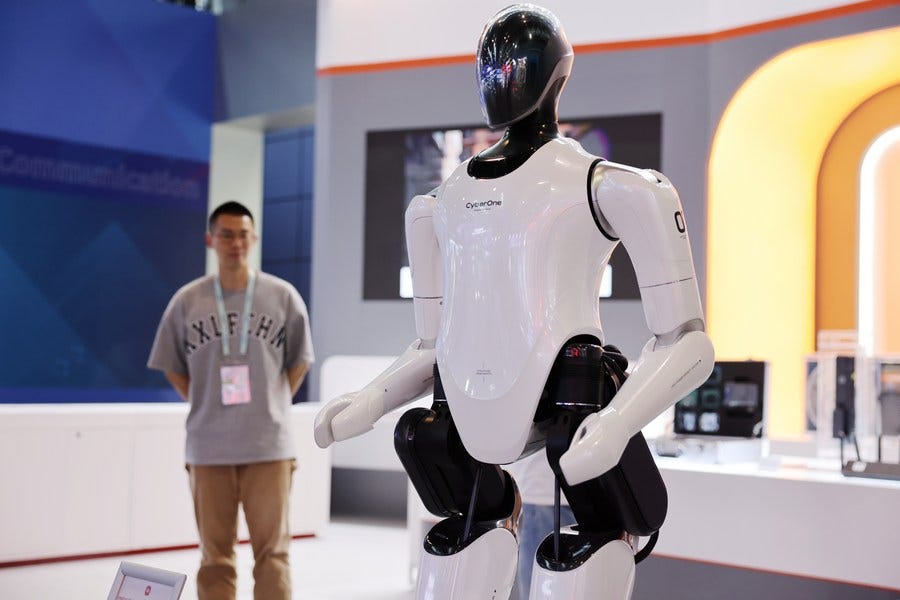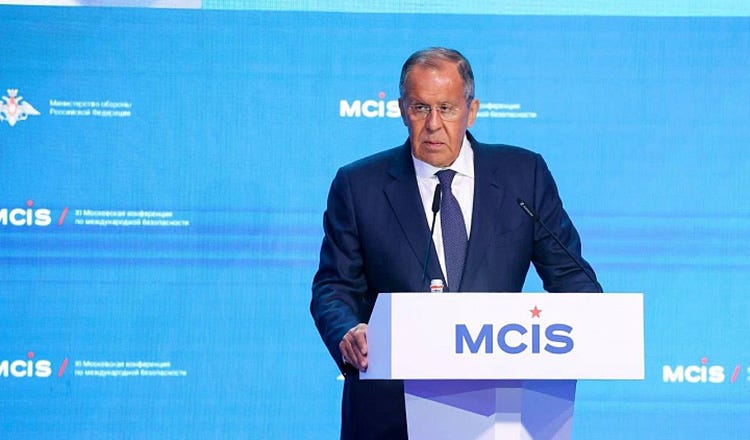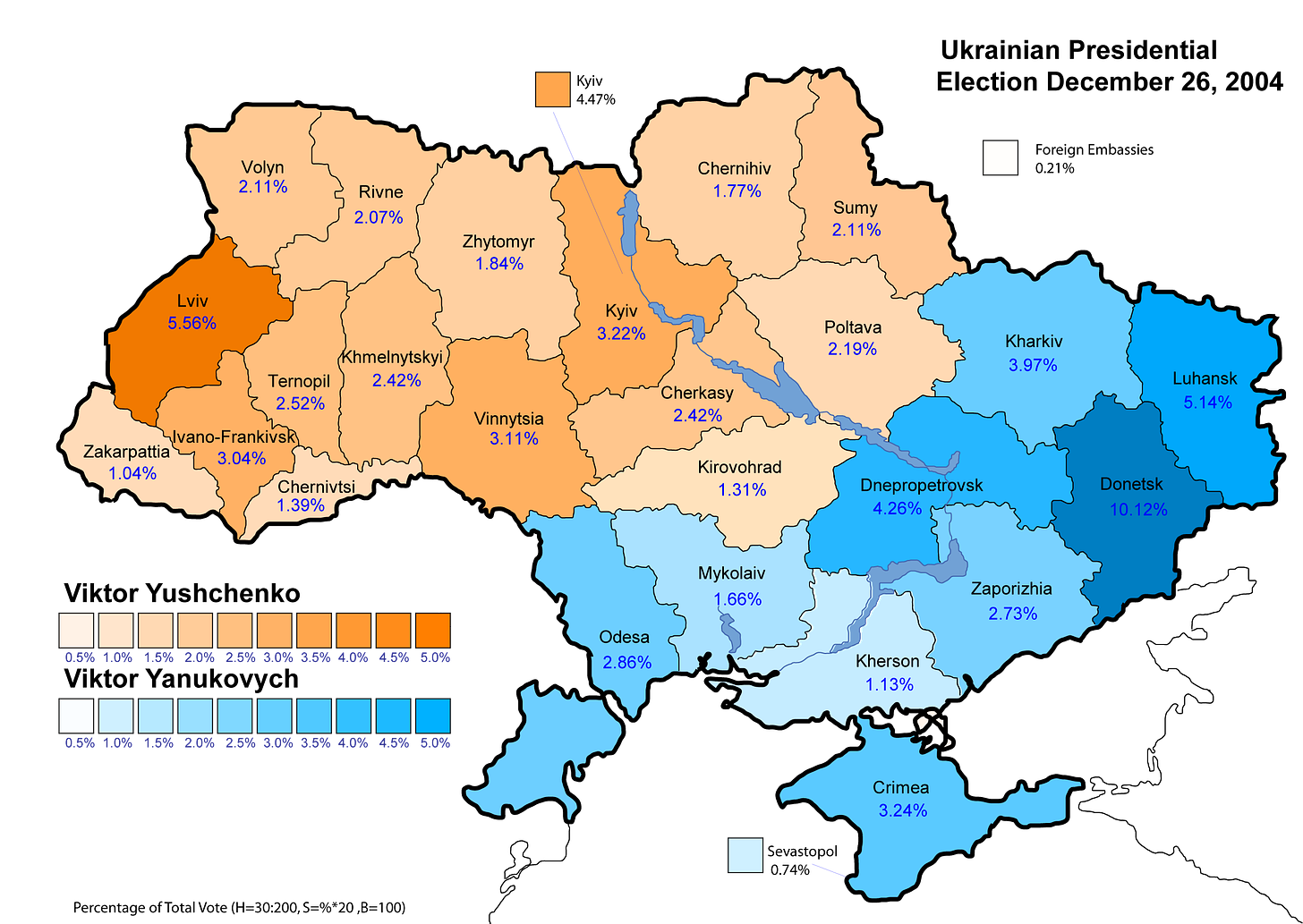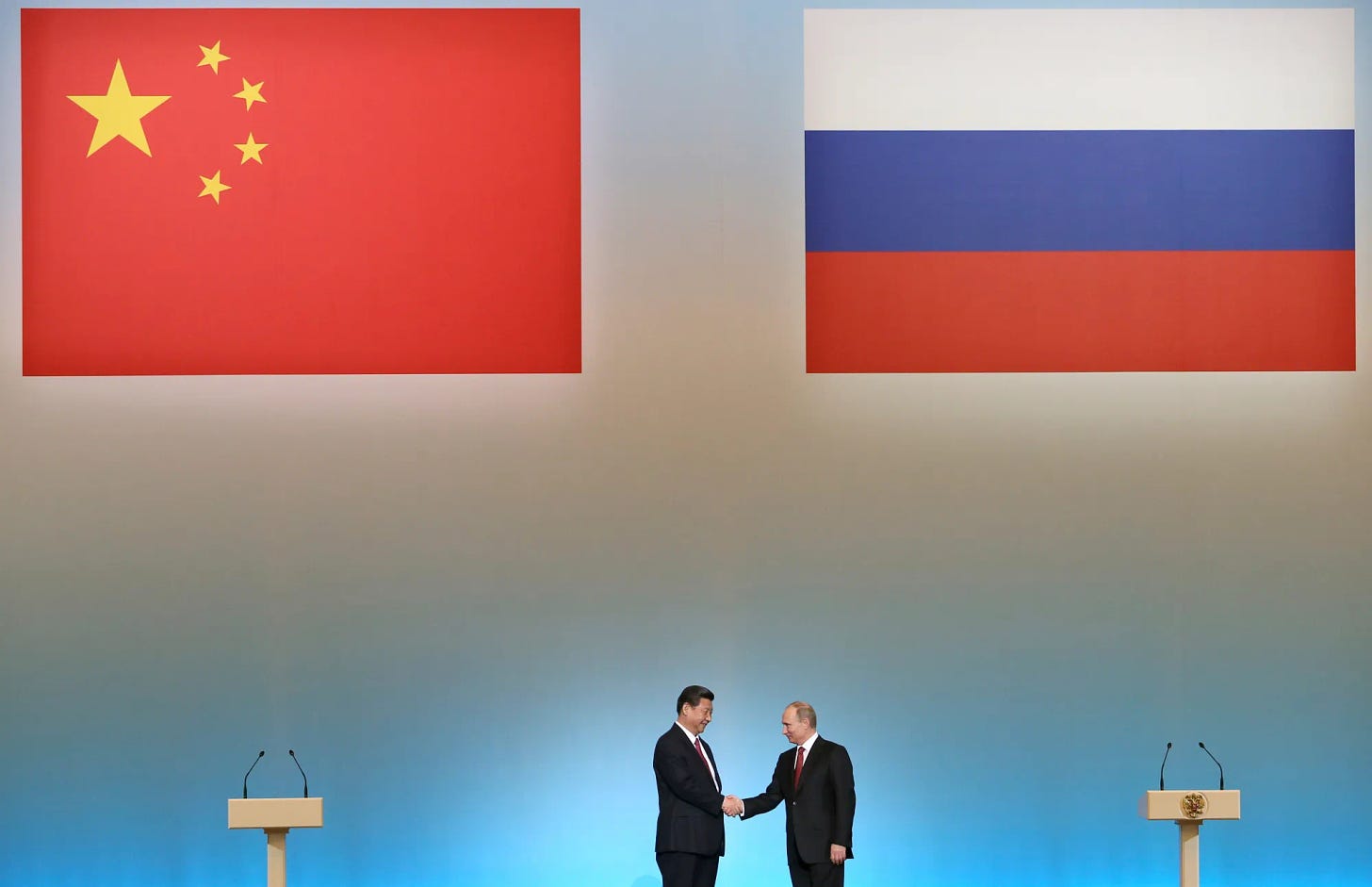Official Policy
Russia lauds India, Global South realistic solutions, Ukraine Peace by Peace, USA Two Fronts, One Goal: Euro-Atlantic Indo-Pacific, ASEAN US$2.7 trillion digital economy, China and the Chip Wars,
UPDATE: Russian Foreign Minister Sergey Lavrov lauded India and other global south countries for promoting “fair and realistic” settlement solutions for the ongoing Ukraine conflict. The proposals by the developing world are based on the understanding of the true causes and nature of ongoing developments, he said.
“The official policy is…” normally means there is an unofficial policy which is pretty much the opposite of that stated in public. That is precisely why last week there was a micro-frenzy when a senior NATO official appeared to suggest that Ukraine might have to accept the loss of land to Russia in return for membership of the Alliance.
How can Europe contribute to alleviating the so-called “two- front” predicament in U.S. strategy. This predicament pertains to the need to uphold deterrence in the Euro-Atlantic and Indo-Pacific regions simultaneously or, should deterrence fail, to fight two wars on concurrent or roughly concurrent timelines.
ASEAN is intensifying its economic integration to improve cross-border trade and investment flows, including by unlocking a potential US$2 trillion in its digital economy by 2030. A regionwide digital economy pact was on the agenda of the 55th Asean Economic Ministers’ (AEM) meeting held in Semarang, Indonesia, on Saturday and Sunday.
The race for supremacy in the semiconductor industry is about much more than just technological dominance. It is about shaping the future of civilization. “Can China ace the chip wars?” This was the central question that framed my talk at the Future of Finance China Forum held in Beijing on July 28. The forum, run by The Asian Banker, served as a critical platform for thought leaders amid the unpredictable economic and financial landscape of 2023.
Russia lauds India’s, Global South’s realistic solutions to resolve Ukraine conflict
MOSCOW – Russian Foreign Minister Sergey Lavrov lauded India and other global south countries for promoting “fair and realistic” settlement solutions for the ongoing Ukraine conflict. The proposals by the developing world are based on the understanding of the true causes and nature of ongoing developments, he said.
“We appreciate China, Brazil, South Africa, Egypt, India and other Global South countries’ sincere interest in promoting the quest for fair and realistic settlement avenues,” Lavrov said while addressing the 11th Moscow Conference on International Security last week.
“President Vladimir Putin and our country’s leadership have repeatedly spoken about this,” he said according to a statement released by the Russian Foreign Ministry.
“It is critically important that the proposals coming from our friends in the developing world are based on a clear understanding of the true causes and nature of ongoing developments as fallout from the West’s efforts to undermine the principle of indivisibility and security,” Lavrov said.
At the conference, Lavrov accused the US of undermining the Treaty on the Non-Proliferation (NPT-Treaty) of Nuclear Weapons through its support of Ukrainian forces in its conflict with Russia.
“The United States has ditched a number of key arms control and non-proliferation agreements. It is also feared that now it is ready to impinge upon the Treaty on the Non-Proliferation of Nuclear Weapons, one of the core elements of the global security architecture,” he said.
The minister claimed that attempts to exclude the AUKUS military bloc from the Treaty on the NPT could jeopardise the agreement’s existence, according to the statement.
Lavrov stated that Western geopolitical engineers are directly provoking crises in various parts of the world.
“Building up their military presence near the Russian borders, the NATO members ignored for many years their promises to the Soviet leaders on the non-expansion of the alliance.
They were crudely violating their commitments, assumed at the top level in the Organization for Security and Co-operation in Europe (OSCE), to observe the principle of equal and indivisible security, not to enhance their own security at the expense of others and to prevent the domination of any party or organisation in Europe.
The OSCE signed these commitments in Istanbul in 1999 and in Astana in 2010,” he said at the conference.
Lavrov also stated that the “collective West,” allegedly to “save” the Ukraine regime, has launched a hybrid aggression against Russia, one pursued in the military, political, legal, economic, and humanitarian spheres.
At the conference, Lavrov expressed his gratitude to participants attending the event and said that despite Western countries’ efforts, many nations came to participate, as per the statement.
The world, said Lavrov, is witnessing large-scale and truly epoch-making shifts. “A fairer and more stable world order, based on cultural and civilisational diversity and a balance of interests of the members of the international community, is fighting to emerge before our very eyes,” he said. ANI
Read more here.
Ukraine Peace by Peace
By Julian Lindley-French
“Hypocrisy is a tribute vice pays to virtue”. Francois, Duc de la Rochefoucauld
August 23rd. On this day in 1939 Nazi Germany and Soviet Russia signed the Non-Aggression Pact” which not only paved the way for Hitler’s September third invasion of Poland but also set the scene for the most climactic event of the twentieth century – the June 22nd, 1941 Nazi invasion of the Soviet Union. It was as cold and calculated an exercise in cynicism and hypocrisy as any in Europe’s long and undistinguished history of hypocrisy. The Pact gave time to both Berlin and Moscow in return for Poland’s land. Is something similar about to happen in Ukraine?
There is a phrase that always raises my concerns: “The official policy is…”. It normally means there is an unofficial policy which is pretty much the opposite of that stated in public. That is precisely why last week there was a micro-frenzy when a senior NATO official appeared to suggest that Ukraine might have to accept the loss of land to Russia in return for membership of the Alliance. For the record, he did not say that. The official in question is known to me and he is the consummate professional. The person chairing the meeting at which he is alleged to have suggested is also one of my closest friends. The suggestion, such as it was, took place as part of a two-hour panel discussion as one of many scenarios that might transpire given the nature, scope, and levels of support for Ukraine. What the reaction did reveal is how many governments are indeed thinking along those lines.
There are certain realities that Ukraine and its Western partners must now confront. As I suggested in May, and despite the heroic efforts of Ukrainian forces, the Ukrainian counter-offensive is stalling because it never had the necessary military weight to break the Russian land bridge in eastern and southern Ukraine, let alone re-take Crimea. At the forthcoming meeting of NATO defence ministers in October it will also become apparent that the Allies have already given 90% of what they are going to give Ukraine, whether it is delivered as promised or not. As the Raputitsa or mud season begins to impose itself the war will become a stalemate. The question will then become what the Alliance and its fellow travellers can do for Ukraine come the spring and the new campaign season. A season, I might add, that will coincide with NATO’s 85th anniversary celebrations in Washington.
The stalemate is about more than two exhausted armies stuck in the Ukrainian mud. The Russo-Ukraine War is also geopolitical Raputitsa. China is determined that Russia will not lose and is supplying Moscow directly with helicopters and other vital materiel, and indirectly using North Korea as a conduit for other materiel. Today, a “Crimea Summit” is taking place in Kyiv with President Zelensky talking about preparations for re-taking Crimea. However, the West, for all its verbal and actual support of Ukraine, has not and is not doing enough to ensure Ukraine has any chance of reclaiming its pre-2014 borders, let alone its pre-1991 borders. The news that the Danish and Dutch will send ‘dozens’ of F-16s to Ukraine with American approval is to be welcomed, but it will not be a war game-changer.
Worse, there are countries inside the Alliance, with Belgium and Italy to the fore, who are suggesting that the war has proven Russia to be a paper tiger and that there is little urgency to fulfil the goals set out in the 2022 NATO Strategic Concept. Any strategy pause, for that is what this stalemate will amount to, will thus give Russia the time and space it needs to learn the lessons of its own incompetence and rebuild its armed forces, whatever the economic consequences. That is precisely what former Russian President Dmitry Medvedev meant when in May he suggested the war could last for decades.
There are several peace initiatives/peace feelers underway, most notably that being proposed by the Saudi Crown Prince Mohammed bin Salman. What strikes me about all these peace initiatives is how very European they are. The history of European peace treaties are traditionally built on a celebrated lack of principle by which the aggressor is partially rewarded for its aggression in return for the aggressed being partially compensated. Even the Congress of Vienna and the treatment of defeated Nazi Germany by the Western Allies fitted that pattern. The only ‘peace’ treaty that did not was the 1919 Treaty of Versailles and that simply created the conditions for World War Two.
Therefore, the governments saying that, “The official policy is…” are looking at alternatives. This is because Ukraine’s backers are not going to step up further which means that when they say it is up to Ukraine to decide when the war ends, it isn’t. At some point there will be a ceasefire, that will turn into some form of typically European ‘peace’ by which Russia gets to hold on to some of the Ukrainian land it has conquered in return for what is left of Ukraine being offered NATO membership.
And, if Ukraine does not get NATO membership? It will be conquered peace by peace.
It is as clear as mud!
Two Fronts, One Goal: Euro-Atlantic Security in the Indo-Pacific Age
In this paper, we outline how Europe can contribute to alleviating the so-called “two- front” predicament in U.S. strategy. This predicament pertains to the need to uphold deterrence in the Euro-Atlantic and Indo-Pacific regions simultaneously or, should deterrence fail, to fight two wars on concurrent or roughly concurrent timelines. Specifically, we have zoomed in on two, interrelated, questions: 1) how can Europeans help free up the United States’ strategic bandwidth in Europe so as to enable proper U.S. prioritization of China without weakening Europe’s deterrence architecture?; and 2) in what ways, if at all, can Europeans contribute to U.S.-led efforts to uphold deterrence in the Indo-Pacific?
When it comes to Europe, we have identified two sets of military-strategic functions that are critical to the sound functioning of deterrence. We think about transatlantic burden- sharing in the context of those two functions: 1) the provision of strategic enablers and the enhancement of deterrence (i.e., through nuclear deterrence, command and control (C2), intelligence, surveillance, and reconnaissance (ISR), ballistic missile defense (BMD), cyber and electronic defense, etc.); and 2) a direct contribution to conventional deterrence through stand-in forces, especially in and around the eastern European “front-line.”
While we expect the United States to continue to play a leading role in the provision of strategic enablers and enhanced deterrence, we argue that Europeans should step up their efforts in this regard. Britain and France would stand out as far as the nuclear level is concerned, but Germany and others can also step up their roles in areas like integrated air and missile defense, ISR or C2. At any rate, greater European responsibility for strategic enablers and enhanced deterrence should not undermine the principle of U.S. leadership, which remains critical for any rebalancing at this level to be strategically credible and politically feasible.
When it comes to providing a direct contribution to conventional deterrence in and around the front-line, we see more potential for a rebalancing in terms of burden- sharing, and for Europeans to take the lead. However, we argue that it is important for the United States to maintain some sort of conventional military role and presence in Europe, for assurance purposes but also to manage escalation dynamics. A European- led effort in conventional deterrence would need to revolve around a Polish-German core within the North Atlantic Treaty Organization (NATO), augmented by other allied countries, and around which Swedish-Finnish, Baltic and Romanian nodes will gravitate in northern, eastern and south-eastern Europe, respectively. Secondly, any credible European-led effort in conventional deterrence presupposes a substantial shift in the way that Europe invests in skills, capabilities and technologies. It also calls for more focus on the EU-NATO relationship, with a need for NATO to continue to focus on the defense planning and operational aspects of deterrence and the European Union (EU) to concentrate on the industrial and technological aspects of deterrence.
Last but not least, and contrary to conventional wisdom, we argue that Europeans can play a strategically meaningful military contribution in the Indo-Pacific, both in peacetime and wartime. The subsurface domain would be particularly critical in any Indo-Pacific contingency, and the combined UK and French subsurface nuclear (SSN) force would constitute around 15-20 percent of the U.S. one, and far above anything U.S. regional allies may be in a position to bring to bear within the next decade at least. Beyond that, Europeans can contribute by securing the sea lanes of communications in the Indian Ocean, which would be important in an Indo-Pacific contingency, but also in other important areas like space and ammunition, as well as investing in a common pool of inter-theater capabilities.
We argue against the notion of a neat division of labor, whereby the United States would leave almost no forces in Europe, and Europeans would refrain from any military role in the Pacific. We recognize that the Euro-Atlantic and the Indo-Pacific regions are separate theaters with different needs, but our vision requires paying greater attention to cross-theater awareness and coordination in key areas like defense, capability and operational planning as well as industrial and technological collaboration.
Our recommendations range from the broad to the specific. We recognize that there can be no credible European contribution to the “two-front” predicament without resources such as substantially increased defense expenditure and investment in military forces and capabilities. While we do not provide a “price tag” for how much more Europeans should spend on defense, we believe they should move beyond the 2 percent of GDP target set in NATO. Relatedly, NATO Europe and the European Union need to take on more responsibility for developing ISR, outer space, cyber defense and electronic warfare capabilities and develop a defense industrial base to produce these technologies. This requires much closer defense planning and industrial cooperation between NATO and the EU to ensure that investments are tailored around concrete operational needs and are being sufficiently and appropriately channeled toward critical defense capabilities. Finally, we also provide specific details on how to operationalize both the German-Polish land and British-French naval cores. To this end, we also call for closer operational and intelligence ties between European nations and U.S. Indo-Pacific Command.
Download PDF here.
ASEAN US$2 trillion digital economy pact by end of 2023
SINGAPORE – Asean is intensifying its economic integration to improve cross-border trade and investment flows, including by unlocking a potential US$2 trillion (S$2.7 trillion) in its digital economy by 2030. A regionwide digital economy pact was on the agenda of the 55th Asean Economic Ministers’ (AEM) meeting held in Semarang, Indonesia, on Saturday and Sunday. Singapore’s Minister for Trade and Industry Gan Kim Yong attended the meeting.
The AEM meeting endorsed a study on the Asean Digital Economy Framework Agreement (DEFA), paving the way for the 10 member countries to start negotiations on the pact, according to a joint Asean media statement. The DEFA negotiations are expected to be officially launched at the 23rd Asean Economic Community (AEC) council meeting and to be officially acknowledged by Asean leaders at the 43rd Asean Summit in Jakarta in September, it said.
Boston Consulting Group has projected that Asean’s digital economy will triple by the end of the decade through the natural adoption of digital technologies, growing to almost US$1 trillion by 2030 from US$300 billion now. Progressive rules in DEFA would double this contribution to US$2 trillion, said a separate Asean statement.
Mr Gan said the annual AEM meeting and the good outcomes from Semarang were testament to the Asean nations’ commitment and efforts to remain open, connected and integrated with one another.
“A rules-based trading environment, and capturing the potential of digitalisation and sustainability are important for businesses in the region. Singapore will continue to work in partnership with Asean member states to deepen Asean’s value proposition as an attractive trade and investment region for our global partners,” Mr Gan said in a statement released by the Ministry of Trade and Industry (MTI).
Asean is Singapore’s largest trading partner in goods and Singapore’s largest investment destination. In 2022, Singapore’s total trade in goods with Asean amounted to $344.3 billion, an increase of about 19 per cent over the previous year, MTI said. Singapore invested $23.9 billion into Asean in 2022, up 8 per cent from the previous year.
The gathering also saw the completion of the Asean Services Facilitation Framework, which aims to foster a more transparent and predictable business environment for companies to engage in cross-border trade in services in the region, said MTI.
Several mutual recognition arrangements were signed for particular areas such as building and construction materials and food safety regulations.
“Collectively, these mutual recognition arrangements will reduce impediments to trade as well as time and costs arising from duplicative retesting, inspection and certification,” MTI said.
The new Asean Tariff Finder was also launched at the AEM meeting. The finder provides a single, user-friendly portal for businesses to access updated information on trade regimes and tariff rates within Asean.
Asean ministers also signed a memorandum of understanding with the World Intellectual Property Organisation to help regional businesses better leverage and monetise their intellectual property (IP). One of the initiatives launched was a one-stop platform for businesses to search Asean IP data.
Read more here.

China and the Chip Wars: a Battle It Cannot Afford to Lose
By Andy Mok
The race for supremacy in the semiconductor industry is about much more than just technological dominance. It is about shaping the future of civilization. “Can China ace the chip wars?” This was the central question that framed my talk at the Future of Finance China Forum held in Beijing on July 28. The forum, run by The Asian Banker, served as a critical platform for thought leaders amid the unpredictable economic and financial landscape of 2023.
While these wide-ranging discussions were informative, my focus was squarely on the place and potential of China in the semiconductor industry. Instead of merely asking if China can win the chip wars, it’s more insightful to consider whether China can afford not to. This reframing provides a sharper understanding of the stakes for China’s economy and its global standing in the semiconductor industry.
“Valuation extravaganza” is a phrase I use to describe the surging market caps of companies like Nvidia and AMD. The remarkable value growth of these companies has raised eyebrows and led to questions about whether we’re witnessing a semiconductor bubble. However, the rational ubiquity of semiconductors, essential to various sectors, might justify these high valuations.
In 2021, over 1.1 trillion chips were shipped worldwide, finding their way into everything from cars and consumer electronics to industrial applications. Semiconductors, quietly yet crucially, have become a part of nearly every aspect of modern life. According to a recent survey of industry executives, the industry’s future direction is being steered by emerging sectors like the metaverse, sustainability, mobility, and digital health – each calling for unique semiconductor capabilities.
This importance of semiconductors is reflected in the market’s response. Nvidia’s stock price tripled last year raising its valuation to more than $1 trillion with a Price-to-Earnings (P/E) ratio over 240. AMD’s stock price has also doubled, its P/E ratio almost reaching 500. This valuation growth is partly due to the robust demand for semiconductors, with the global market projected to grow to $1.8 trillion by 2032.
Even with the current chip shortage, some industry observers argue that these high valuations are justified. They view the long-term growth prospects for the industry as strong and believe these valuations are based on the expectation of persistent semiconductor demand.
Despite short-term disruptions like the global chip shortage, the long-term outlook for the semiconductor industry remains bright. Semiconductors play an integral role in the global economy, and their importance will continue to grow in the future, shaping our tech-driven world in ways we’re only beginning to understand.
We must also consider the potential drivers of future chip demand, taking into account the radical changes that advances in artificial intelligence (AI) may bring. A compelling perspective on this comes from Sam Altman, a prominent figure in the tech industry and CEO of OpenAI, in his manifesto “Moore’s Law for Everything”.
Altman applies the principle of Moore’s Law, which traditionally refers to the exponential growth in computing power, to a broader societal context, predicting a future where rapid growth permeates all facets of our lives and economy. Coined by Intel’s co-founder Gordon Moore, the law originally observed that the number of transistors on a microchip double roughly every 18 months. Altman, however, envisions its implications beyond the realm of computing power.
This broader interpretation anticipates an era of abundance, where the ubiquitous adoption of AI causes a steep drop in labor costs that fundamentally transforms society. Altman posits that as automation replaces human tasks from plumbing to R&D, labor costs will plunge, leading to significantly cheaper goods and services. The cost of the essential inputs shifts from labor and raw materials to data, driving prices towards zero and marking the advent of an era of profound abundance.
But abundance here isn’t just about an increase in available goods and services. It’s also about equalizing access to these resources, democratizing what was once the exclusive privilege of the affluent. High-quality healthcare, education, travel experiences, and even a secure standard of living—Altman’s vision suggests these will be accessible to far more people, with the cost of a “great life” approaching zero.
At the core of this transformation is AI, its learning and decision-making abilities propelling us towards this era of abundance. Yet, the manifestation of this AI-driven prosperity depends heavily on a robust, efficient, and advanced computational infrastructure— semiconductors or chips. Semiconductors are the foundation of our digital world, powering everything from personal devices to advanced machinery.
The complexity and scale of AI necessitate more advanced and efficient semiconductors. The AI algorithms promising this era of abundance require enormous computational power to process large volumes of data and make complex calculations. The task of providing this computational power depends on a wide range of semiconductors.
The abundance that Altman predicts will not only be driven by AI but will also critically hinge on the availability and advancement of semiconductors. In the coming era of AI-driven abundance, those countries and companies that can ensure a stable supply of chips will hold the upper hand. Thus, as China strategizes to win the chip wars, the stakes become clear—it’s not just about surviving but thriving in this world of unlimited abundance.
In the global context of the race for technological supremacy, the semiconductor industry is emerging as a key battleground. The rise of artificial intelligence (AI), with its potential to usher in an era of unprecedented abundance and revolutionize labor economics, amplifies the national security implications of the semiconductor industry. Indeed, the ‘resilient redesign’ of the global supply chain is becoming an essential facet of national strategies to ensure sustained success in this critical sector.
The complex web of today’s supply chain, spanning continents and countless entities, is inherently vulnerable to geopolitical shocks and pressures. The need for countries to develop resilient domestic capacities is becoming increasingly clear. Governments worldwide are already showing a keen interest in the sector’s growth and security, a trend that is set to heighten as strategic reorientations, regulatory shifts, and a heightened focus on security come into play. The semiconductor industry is becoming a significant geopolitical flashpoint, a field of intense competition for technological dominance.
In the context of China’s domestic politics, this resonates profoundly with President Xi Jinping’s vision of ‘common prosperity’. The potential abundance enabled by AI could pave the way for realizing this vision, democratizing access to what is currently available only to the affluent and creating a more equal society. The era of abundance that Sam Altman envisions could, in fact, help manifest President Xi’s aspiration for the rejuvenation of the Chinese nation.
In this light, China’s broad conception of national security – which encompasses not only traditional military aspects but also economic and even cultural security – becomes particularly relevant. The advancements in AI, underpinned by the semiconductor industry, will be vital for maintaining and enhancing China’s national security in this broad sense.
Therefore, China cannot afford to lose the ‘chip war’. The stakes are beyond high – economic vitality, technological advancement, geopolitical influence and even the future of the human race. The semiconductor industry is not just another industry; it is a cornerstone upon which human civilization may be decided.
In conclusion, the race for supremacy in the semiconductor industry is about much more than just technological dominance. It is about shaping the future of civilization. For China, acing the chip wars is not just a matter of national security in the traditional sense. It is also about securing the future of its society and realizing its vision of prosperity for all.
Read more here.







